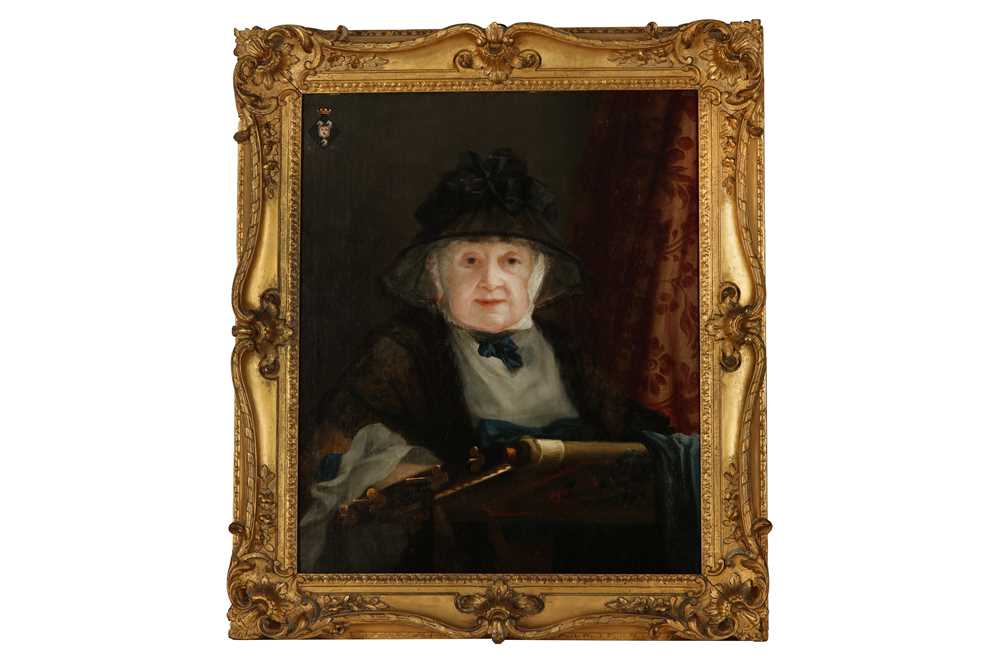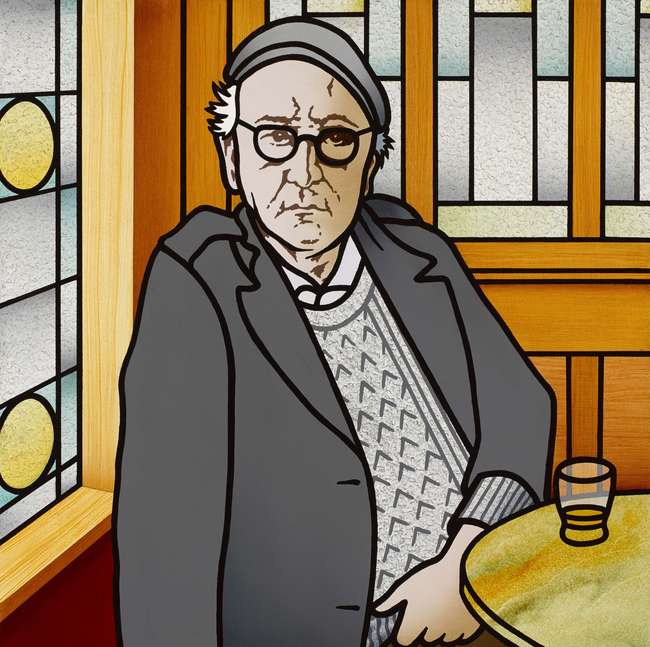ROBERT HOME (BRITISH 1752-1834) PORTRAIT OF LIEUTENANT-COLONEL WILLIAM SYDENHAM AND HIS WIFE, WITH ST THOMAS'S MOUNT, MADRAS IN THE BACKGROUND Oil on canvas 77.5 x 92.1cm (30½ x 36¼ in.)Painted circa 1791.Provenance: Arthur Tooth, London, 1946-7 (advertisement in The Connoisseur, March 1946) Private collection, UK Literature: Mildred Archer, India and British Portraiture 1770-1825, London 1979, pp.306-8, pl.212 William Sydenham (1752-1801), the son of Samuel Sydenham and Alice (née Chapman) of Minehead, came from a distinguished Devonshire family. He joined the East India Company's Madras Artillery as a Cadet in 1768. In 1776 he married Amelia Prime, niece of General Horne, who had also served with the Artillery in India. In 1786, at the time of the war with Tipu Sultan of Mysore, Sydenham was promoted to Lieutenant-Colonel in command of the First Battalion at St Thomas's Mount near Fort St George, Madras, which can be seen in the background of this painting. Home was a fine landscape painter and detailed landscape backgrounds give extra vividness to his portraits. William Sydenham was promoted to Major-General, Commandant of Artillery and AuditorGeneral of Fort St George in January 1801, but died in June of that year. Robert Home was an important recorder of British India in the late eighteenth and early nineteenth century. He studied with Angelica Kauffmann and between 1773 and 1778 worked in Italy. He exhibited twenty paintings at the Royal Academy between 1770 and 1789. His wife died in 1790 and the following year travelled to Madras to seek his fortune, just as General Cornwallis was setting off with the Grand Army for the Third Mysore War against Tipu Sultan. Home accompanied the campaign, making sketches of the forts and engagements; he later produced prints of Select Views in Mysore (1794) and paintings of Lord Cornwallis receiving the sons of Tipu Sultan as hostages and The death of Colonel Moorhouse (both c.1793-4; National Army Museum, London). Influenced by Thomas and William Daniell who visited Madras in 1792, Home produced a number of landscapes which show exquisite attention to architecture and Indian life. In 1795 Home moved to Calcutta; he made a happy second marriage and his children joined him in India, all four sons becoming members of the East India Company's army. Home, a punctual, amiable and hardworking man, became the chief portrait painter in Calcutta. He painted the Governor-General of India, Marquis Wellesley, and his brother Major-General the Hon. Sir Arthur Wellesley (the future Duke of Wellington), as well as other generals and judges. He made a short visit to Dacca in 1799 to paint the Nawab Nasrat Jang. Home's successful portrait practice was threatened by competition from Thomas Hickey who arrived in Calcutta in 1807, and by the dashing and eccentric George Chinnery who arrived in 1811. In 1814 Home took up the post of Court Painter to the Nawab of Oudh at Lucknow. He worked for the Anglophile Nawab Ghazi-ud-din Haidar for thirteen years, painting portraits and court life, and designing Ghazi's crown when he was made King of Oudh in 1819, as well as carriages, boats, furniture, even an elephant goad. Home retired to a 'handsome establishment' at Cawnpore after Ghazi-ud-din's death in 1827, dispensing 'extensive hospitality to the residents of the station' until his own death at the age of eighty-two in 1834
ROBERT HOME (BRITISH 1752-1834) PORTRAIT OF LIEUTENANT-COLONEL WILLIAM SYDENHAM AND HIS WIFE, WITH ST THOMAS'S MOUNT, MADRAS IN THE BACKGROUND Oil on canvas 77.5 x 92.1cm (30½ x 36¼ in.)Painted circa 1791.Provenance: Arthur Tooth, London, 1946-7 (advertisement in The Connoisseur, March 1946) Private collection, UK Literature: Mildred Archer, India and British Portraiture 1770-1825, London 1979, pp.306-8, pl.212 William Sydenham (1752-1801), the son of Samuel Sydenham and Alice (née Chapman) of Minehead, came from a distinguished Devonshire family. He joined the East India Company's Madras Artillery as a Cadet in 1768. In 1776 he married Amelia Prime, niece of General Horne, who had also served with the Artillery in India. In 1786, at the time of the war with Tipu Sultan of Mysore, Sydenham was promoted to Lieutenant-Colonel in command of the First Battalion at St Thomas's Mount near Fort St George, Madras, which can be seen in the background of this painting. Home was a fine landscape painter and detailed landscape backgrounds give extra vividness to his portraits. William Sydenham was promoted to Major-General, Commandant of Artillery and AuditorGeneral of Fort St George in January 1801, but died in June of that year. Robert Home was an important recorder of British India in the late eighteenth and early nineteenth century. He studied with Angelica Kauffmann and between 1773 and 1778 worked in Italy. He exhibited twenty paintings at the Royal Academy between 1770 and 1789. His wife died in 1790 and the following year travelled to Madras to seek his fortune, just as General Cornwallis was setting off with the Grand Army for the Third Mysore War against Tipu Sultan. Home accompanied the campaign, making sketches of the forts and engagements; he later produced prints of Select Views in Mysore (1794) and paintings of Lord Cornwallis receiving the sons of Tipu Sultan as hostages and The death of Colonel Moorhouse (both c.1793-4; National Army Museum, London). Influenced by Thomas and William Daniell who visited Madras in 1792, Home produced a number of landscapes which show exquisite attention to architecture and Indian life. In 1795 Home moved to Calcutta; he made a happy second marriage and his children joined him in India, all four sons becoming members of the East India Company's army. Home, a punctual, amiable and hardworking man, became the chief portrait painter in Calcutta. He painted the Governor-General of India, Marquis Wellesley, and his brother Major-General the Hon. Sir Arthur Wellesley (the future Duke of Wellington), as well as other generals and judges. He made a short visit to Dacca in 1799 to paint the Nawab Nasrat Jang. Home's successful portrait practice was threatened by competition from Thomas Hickey who arrived in Calcutta in 1807, and by the dashing and eccentric George Chinnery who arrived in 1811. In 1814 Home took up the post of Court Painter to the Nawab of Oudh at Lucknow. He worked for the Anglophile Nawab Ghazi-ud-din Haidar for thirteen years, painting portraits and court life, and designing Ghazi's crown when he was made King of Oudh in 1819, as well as carriages, boats, furniture, even an elephant goad. Home retired to a 'handsome establishment' at Cawnpore after Ghazi-ud-din's death in 1827, dispensing 'extensive hospitality to the residents of the station' until his own death at the age of eighty-two in 1834






.jpg)








Testen Sie LotSearch und seine Premium-Features 7 Tage - ohne Kosten!
Lassen Sie sich automatisch über neue Objekte in kommenden Auktionen benachrichtigen.
Suchauftrag anlegen